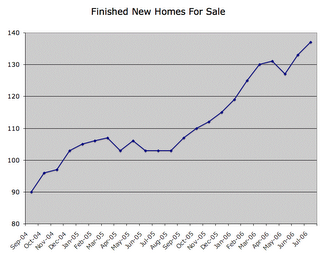Builders Burning Through Cash While Amassing Inventory
The publicly traded homebuilders were amazingly aggressive in their land acquisition strategies over the past several years, and they are paying for it now in interest expense and write-downs. On their income statements all but 3 of the smallest builders are still showing large profits. However, cash flow statements show that the builders are burning through cash and increasing borrowings at an alarming rate. With sales in the early stages of a long, steep decline, they are putting themselves at the mercy of creditors, which I expect will result in bankruptcy for some of them. I took a good look at the cash flow statements of all the publicly traded homebuilders.
For the group of 15 builders who have reported cash flows for a quarter ending 6/30/06:
1. Their total cash position dropped $908,566,000 during Q2 '06, vs. $132,668,000 during Q2 '05. It's normal for the builders to use cash building homes in Q2 that will be closed on in Q3 and Q4. However, this year builders are spending much more money on spec homes that haven't been sold yet and are seeing many more last minute cancellations that leave them short on cash.
2. Along those same lines, net borrowings increased by $2,942,020,000 during Q2 '06 vs. $1,483,781,000 during Q2 '05. That's an additional $1.5 billion borrowed by perhaps 15% of the nation's total homebuilding industry. Multiply that out, and you have a pretty substantial boost to the money supply. Much of it was just the expansion of credit facilities, but a good portion was also in the form of new long term bonds. While builders are burning through all this cash, they are booking most of it as inventory and thus avoiding a blow to profits, but in the meantime...
3. They increased money spent on share repurchases to $558,006,000 during Q2 '06, vs. $207,069,000 during Q2 '05. Just as they thought increasing land holdings to 6 years supply or more was a good idea in 2005, many of them seem to think that borrowing money to repurchase shares is a good idea right now. While share prices are low now relative to the same time last year, I believe that several builders will see their prices fall all the way to zero before the current shakeout is complete.
Not all builders are responding to the slowdown equally. NVR, MDC and TOA all borrowed less this Q2 than they did last Q2 and their cash positions fared better this year as well. MDC and TOA never spent money on share repurchases and NVR dramatically reduced theirs when the market turned, spending nothing during Q2 '06. By accepting the harsh reality of the bursting housing bubble early, they greatly increase their chance of surviving it.
On the worst end you have WCI, with a rapid deterioration of their cash position (93% lower than a year ago), a 461% increase in Q2 borrowings (to $217.8 million) and $43,580,000 spent on share repurchases last quarter. They face huge problems with about half of their revenues historically coming from Florida condo sales and the story is being told in their cash flow statements. Perhaps they are repurchasing shares because they are dumb enough to think their stock is a bargain right now. Perhaps they just want to prop up the share price long enough for insiders to cash out before the collapse.
The biggest builders were of course the biggest borrowers, with DHI, PHM & CTX borrowing $687.4, $716.1 & $840.5 million respectively during the quarter. How long their creditors will continue to finance their building of more homes than people want to buy remains an important question. DHOM already seems to be hitting a financing wall. If they can't get enough money to pay the bills from customers or the banks, then bankruptcy will soon follow.
All of the data above covers the June quarters, while cancellation numbers didn't really turn ugly until July and August. TOL and HOV report quarters ending July 31st, but they are more conservative than most. TOL followed the trends of the June builders, but the damage wasn't too extreme. HOV should file its 10-Q next week. KBH and LEN report quarters ending August 31st, and it should be especially interesting to see the fincing portion of their cash flow statements as they are two of the more aggressive builders.

<< Home